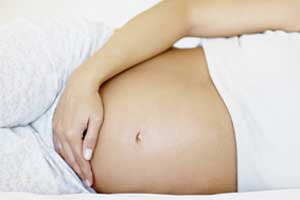- Home
- Editorial
- News
- Practice Guidelines
- Anesthesiology Guidelines
- Cancer Guidelines
- Cardiac Sciences Guidelines
- Critical Care Guidelines
- Dentistry Guidelines
- Dermatology Guidelines
- Diabetes and Endo Guidelines
- Diagnostics Guidelines
- ENT Guidelines
- Featured Practice Guidelines
- Gastroenterology Guidelines
- Geriatrics Guidelines
- Medicine Guidelines
- Nephrology Guidelines
- Neurosciences Guidelines
- Obs and Gynae Guidelines
- Ophthalmology Guidelines
- Orthopaedics Guidelines
- Paediatrics Guidelines
- Psychiatry Guidelines
- Pulmonology Guidelines
- Radiology Guidelines
- Surgery Guidelines
- Urology Guidelines
Decreasing Supine sleeping during pregnancy benefits maternal and fetal health

An intervention to reduce supine sleep in late pregnancy may be beneficial for the health of mother and fetus, suggests a new study published in the Journal of Clinical Sleep Medicine.
Jane Warland, associate professor at the School of Nursing and Midwifery at the University of South Australia in Adelaide, and colleagues conducted the study to test whether a customized positional therapy device, PrenaBelt, would reduce time spent sleeping supine and evaluate any change in maternal or fetal parameters, in a group of healthy pregnant women in the third trimester of pregnancy.
The study involved analysis of 25 healthy pregnant women, who underwent an in-home, overnight sleep study during late pregnancy (32–38 weeks). They were then observed for two nights: one night with no intervention, and one night while wearing the PrenaBelt (with intervention).
Maternal heart rate, blood oxygen saturation, and sleep and breathing parameters were assessed using a finger-based plethysmography device. Sleep position was recorded with a body position sensor that was inserted in the PrenaBelt. Fetal and maternal heart rate also were recorded using a device that monitors the electrical signals on the mother's abdomen.
Also Read: Supine sleep position during pregnancy associated with late stillbirth
Key Findings:
- Video-determined time in bed was not significantly different during intervention and control nights.
- Median time spent supine during the intervention night was reduced from 48.3 minutes to 28.5 minutes during the control night.
- The difference in the proportion of time spent supine was significant.
- There was no significant difference in objectively estimated sleep time.
- An improvement was observed in both maternal and fetal parameters during the intervention night with an increase in median minimum maternal oxygen saturation (control = 91.6%, intervention = 92.4%), fewer maternal oxygen desaturations (control = 7.1, intervention = 5.9), and fewer fetal heart rate decelerations (control = 14.0, intervention = 10.4) compared to the control night.
"Our findings suggest that women can comfortably sleep wearing a device around their waist that effectively stops them from sleeping on their back," said Dr. Warland.
Most pregnant women spend about 25 percent of their sleep time in the supine position, which may be a risk factor for stillbirth and low birth weight, according to the authors. This relationship may be due in part to an exacerbation of sleep-disordered breathing and deprivation of oxygen to the fetus when sleeping on the back. While positional therapy is a well-accepted way to reduce supine sleep time and increase side-sleeping in adults with sleep-disordered breathing, no prior studies have examined its use in pregnant women.
"Wearing a device that minimizes back sleep, and which is comfortable and doesn't impact the mother's sleep length or quality, maybe a simple way to reduce stillbirth incidence, especially if the mother is at increased risk due to other factors," Warland said.
"Our results provide preliminary evidence that an intervention to reduce supine sleep in late pregnancy may provide maternal and fetal health benefits, with minimal effect on the maternal perception of sleep quality and objectively estimated sleep time. Further research to explore relationships between objectively determined maternal sleep position, maternal respiratory indices, and fetal well-being is warranted," concluded the authors.
For further reference follow the link: http://dx.doi.org/10.5664/jcsm.7280

Disclaimer: This site is primarily intended for healthcare professionals. Any content/information on this website does not replace the advice of medical and/or health professionals and should not be construed as medical/diagnostic advice/endorsement or prescription. Use of this site is subject to our terms of use, privacy policy, advertisement policy. © 2020 Minerva Medical Treatment Pvt Ltd